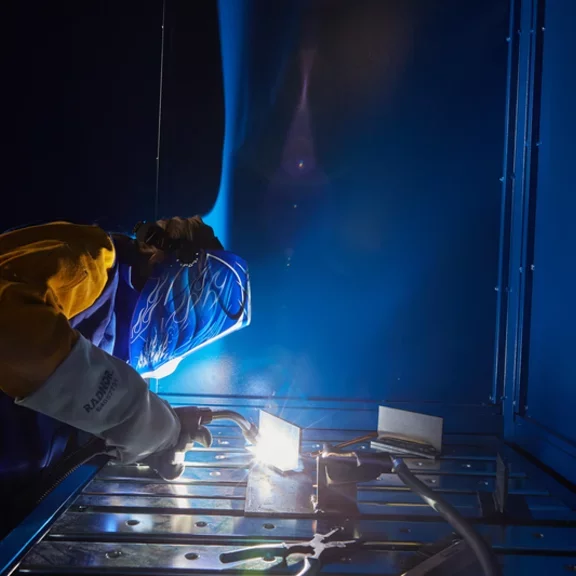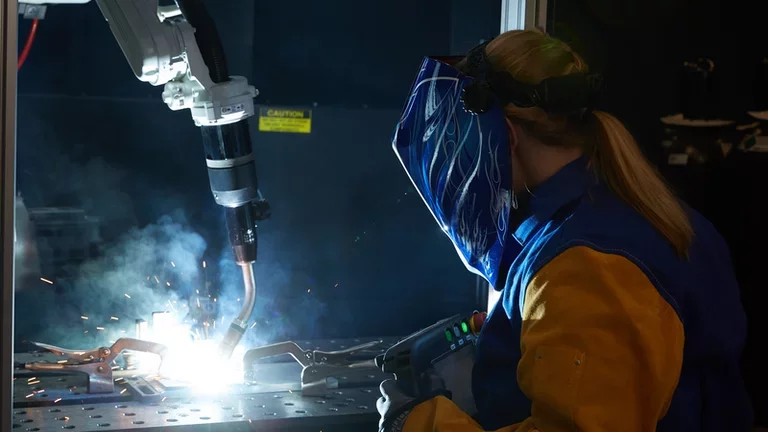Welding and Cutting
Shielding and cutting gases to get the desired finish.
What is a key priority for your workshop?
Get in touch with our team to discuss more about how our products and services can support you.
MIG, MAG, TIG and Other Welding Methods
Welding refers to a group of methods to permanently join two or more workpieces. The components may by joined by using heat, Welding is an industrial process that generally assembles parts, machines and structures by fusing two or more metal workpieces using heat and with or without filler materials (usually in the form of rods or wires). Melted rods or wires build the connection by solidifying in the joint between the joining partners. The metals could be aluminium, carbon steel, etc. For this, it is necessary to reach the melting temperature of the metals.
The most common welding methods are Tungsten Inert Gas (TIG), Gas Metal Arc Welding (GMAW) more commonly known as MIG or MAG welding and laser welding.
There are also other processes such as:
- plasma welding
- GTAW
- FCAW
- torch welding
- resistance/spot welding
- submerged arc welding
- rotational friction welding
Frequently Asked Welding Questions
Why are shielding gases needed during fusion welding?
Shielding gas protects the molten weld pool from oxygen, nitrogen, hydrogen and moisture in the atmosphere. It also helps to protect the filler metal against oxidation.
What are the most common shielding gases used in the GMAW and GTAW welding process?
| GTAW | Argon, Helium, Ar/H2 and Ar/He mixture |
| GMAW | CO2, Ar/CO2 mixture |
What are the most common welding defects?
Metal droplets that land on the surface cause spatter, which normally impacts just the appearance of the weld. Large spatters may harden and affect structural capabilities, thereby increasing welding costs.
Improper shielding gas volumes lead to trapped gas bubbles in the weld pool. As a result, porosity weakens the weld strength and manifests as blow holes or pits in severe cases. Smaller gas molecules also contaminate the weld metal.
Exposure to oxygen during causes a heat tint and leaves stainless steel more susceptible to corrosion. Insufficient shielding, excessive heat, etc. alters the colour of the steel by reducing its chromium content.
Oxygen, Laser and Plasma Cutting
In industry, the choice of the process and the cutting machine are made according to various criteria -- in particular:
- the thickness (low, medium or high thicknesses)
- the type of material (special metals, steels, aluminum or alloys)
- the choice of mode (manual or automated)
- the expected quality (precision, deformation)
- productivity (cutting speed, automation)
Laser Cutting
With laser cutting, complex dimensionally accurate components can be produced in a reproducible manner with a narrow section, small heat affected zone and excellent cut quality.
The process is easy to automate and very cost-effective when processing thin metals. Within the automotive industry, laser cutting has become an established method for, for example, hot processing of body parts. With an extensive product portfolio under the LASAL™ brand, Air Liquide offers the right solution for all needs.
Air Liquide's LASAL™ range is the solution for laser cutting. It offers you the assist gases LASAL™ 2003 (Oxygen) and LASAL™ 2001 (Nitrogen) to maximise the productivity of your laser machine, as well as a wide selection of laser gases adapted to the specifications of your CO2 laser cutting machines.
The LASAL™ range of gases is supported by a full range of equipment solutions designed to ensure the high quality of our gases is maintained through to the point of use. Air Liquide can provide you with a cost-effective solution that delivers your laser gases at the flow-rate, pressure and purity that your laser system demands.
Fuel Gases for Cutting
For the flame during cutting burning, "ordinary" fuel gases can be used, i.e. acetylene, propane, natural gas (methane) or ethylene.
When cutting with a machine, cost efficiency is an important criterion, but operating conditions such as gas supply, gas prices, gas consumption also matter. It is important to have a powerful flame (fuel gas) to start the cutting process and carry out the cutting burn.
The combustion of hydrocarbon compounds takes place in two stages. In the primary flame, the added oxygen results in incomplete combustion. In the secondary flame, the fuel gas is completely burned through the absorption of oxygen from the surrounding air.
The fuel gases differ in flame temperature and ignition/burning speed and thus the primary flame power. When it comes to gas combustion technology, the effect of the primary flame is of particular importance.
Plasma Cutting
With plasma cutting, you can cut all electrically conductive materials, such as unalloyed, low-alloyed and high-alloyed steel, nickel, copper, brass, bronze and aluminium.
The method is used when the material can no longer be processed using cutting firing. The tapering effect of the cutting nozzle strongly concentrates the arc – the material in the cut melts and is blown out by the plasma gas. Plasma gases must not react with the electrode, and you must select a plasma gas suitable for the material. We advise you when to choose and offer the right solution for your process with ARCAL™ Prime, ARCAL™ 15 or nitrogen.
Allow us assess the best product for your workshop
Our experts will help you choose the right gas for your metal fabrication operations and give you advice on the use of related equipment. In this way, it is possible to obtain consistent and high-quality finishes in complete safety.
Premium Gases
-
Industry Leader
We are a global leader in gases, technologies and services for Industry and Health. -
Reliability
Our solutions are reliable, reproducible and in compliance with stringent and ever-evolving regulations. -
Expertise
Leverage our global network of industry experts tailored to your unique challenges. -
One-Stop Solution Provider
Access a comprehensive suite of products, supply modes, and services designed for your specific requirements. -
Focus on Quality
Expect nothing less than the highest standards in process and product quality. -
Sustainability
Embrace our solutions that support your highest performance while minimising environmental impact.
Contact Us
Let our team get back to you on your specific enquiry.








